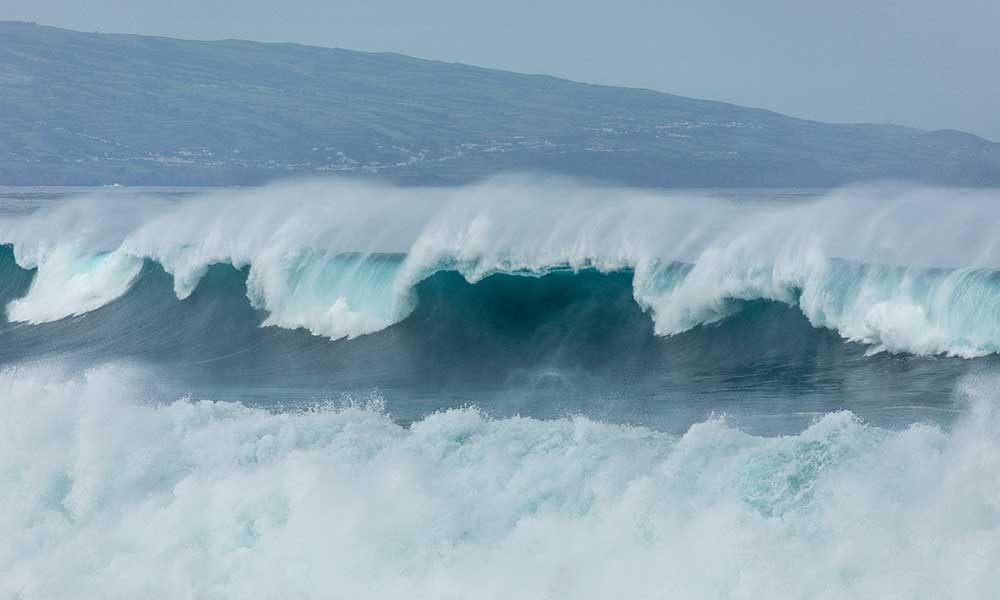A leisurely, laid-back surf for one surfer can be a massive challenge for another. If you’re a beginner or an intermediate, you will experience days when the surf is a little too high and heavy and you feel that you’re way out of your depth.
The best way to surfer bigger waves is to work your way up in terms of wave size. Once you get proficient surfing 3 foot waves, move to 5 foot waves and so on. Don’t surf waves you aren’t comfortable surfing and never surf bigger waves alone.
If it’s too treacherous for your skillset, it might be best to stay on the beach and watch more experienced surfers catch waves.
But what happens when you’re on the water and the crest of a 6, 7 or 10 foot wave is bearing down on you?
The name of the game to surfing big waves is preparation. It is wise to work your way up to bigger surf.
Don’t jump into 6′ days if your comfort level is 2′ waves.
Progress to days when the waves you surf are 3 to 4 feet. Then consider surfing bigger waves from there.
How to Tackle Big Waves When You’re Inexperienced
If the waves are big and heavy and you don’t have the skill to tackle them, it’s probably time to get out and find a calmer surf spot.
If you keep facing off against waves that are beyond your skill level, you’re only going to risk damaging your surfboard, body and quite possibly someone else’s body.
What do you do when a wave is too big?
If you decide to head straight for those big waves, keep the following in mind that you can turn tail and ride a wave in on your stomach at any time.
Divers have a saying, “Any diver can cancel any dive at any time.”
The same holds true for surfers. If you don’t feel comfortable, paddle in.
If conditions are a healthy version of challenging
- Do not hesitate. Make sure you’re committed to riding the wave. You’re going to need that confidence to catch waves.
- Paddle to where wave is going to break.
- From here, you can choose to ride the wave, paddle over it, or if you timed it wrong you can push under it.
- If you have a shortboard, you can duck dive to get underneath it. If not, you’ll need to do a turtle roll.
To perform a turtle roll, just lay flat on the surfboard, grip the rails tightly, and then flip it over, so that you’re underneath the water and the bsurfboardoard is above you. The wave should wash over you fairly harmlessly on smaller days. On bigger days your should hold onto your surfboard like your life depends on it to prevent it from getting ripped out of your hands.
How Do You Bail A Surfboard?
If it’s too late to turtle roll, you can just toss the surfboard horizontally to the wave and dive down.
Don’t dive under the wave and leave your surfboard perpendicular to the incoming wave.
If a big enough wave breaks on your surfboard, it can break the surfboard in half.
Critical Considerations To Bailing Your Surfboard
- Never ditch your surfboard if someone is in back of you. You can send someone to the hospital.
- Never let your surfboard get between you and the wave. Doing so can result in getting hit by your own surfboard and you will be the one to go to the hospital
- Your surfboard leash will break at some point. Be prepared to swim to shore.
- Don’t freak out. If you find yourself in a bad situation DO. NOT. FREAK. OUT. Stay calm and make it to shore.
- Don’t be afraid to call for help before you are in over your head.
Once you ditch your surfboard the most likely situation is that the wave will drag your surfboard and your surfboard will drag you with it.
Hold your breath, wait for the wave energy to stop and pop up to the surface with your hands in front of your face.
Be prepared to take another breath and dive to avoid another machine wash compliments of the ocean and Mother Nature.
What Is Tombstoning In Surfing?
On bigger days, say when the wave are 8 feet and bigger, you may experience what is called tombstoning.
Tombstoning can happen when you wipeout or otherwise lose your surfboard resulting in your surfboard being dragged towards the beach, stretching your surf leash to its maximum length.
You will see your surfboard standing straight up and down with only about 2 feet of the nose of your surfboard sticking vertically out of the water, looking like a tombstone.
The reaction from most surfers is to immediately pull their leashed foot towards them.
This only tightens the leash making the situation worse.
The way to remedy tombstoning is to swim just a bit closer to the surfboard which will lessen the tension on the leash.
Your surfboard will pop to the surface and you can then pull it towards with your leash.







